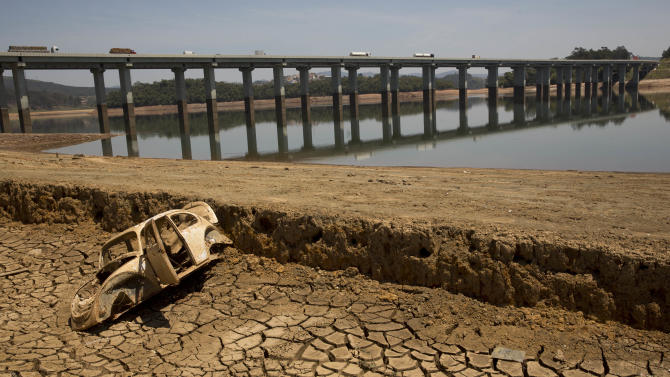Sao Paulo, Brazil, Home of the Rebuilt Solomon's Temple, is Running Out of Water
Biggest reservoir for Brazil's largest city is running dry

January 17, 2015
AP - Halfway through the rainy season, the key reservoir for the hemisphere's largest city holds just 6 percent of its capacity, and experts warned Friday that Sao Paulo authorities must take urgent steps to prevent the worst drought in more than 80 years from drying it out.
The system of reservoirs and rivers that provide water to millions in this city have received less rainfall than hoped during the first weeks of the wet season, raising fears they won't be replenished as hoped. Rainfall during the first two weeks of January totaled just 2.9 inches (7.1 centimeters), well below the historic average for the month of 10.7 inches (27.1 centimeters).
The biggest problem is in the Cantareira water system, which is the largest of six reservoirs that provide water to some 6 million of the 20 million people living in the metropolitan area of Sao Paulo city. Cantareira is now down to 6 percent of its capacity of 264 billion gallons (1 trillion liters), the water utility Sabesp said on its website.
Of the remaining five systems, Alto Tiete is at 11 percent of capacity, Rio Claro 25 percent, Alto Cotia 30 percent, Guarapiranga 40 percent and Rio Grande 70 percent.
"The water supply situation is critical and could become even more critical if the lack of rain and hot weather continue and effective demand management techniques are not created," Mario Thadeu Leme de Barros, head of the University of Sao Paulo's hydraulic engineering and environmental department, said by phone.
"Sao Paulo's water situation is in the intensive care unit and the worse will only be avoided if these measures are adopted and, of course, if it starts raining more," he Barros said.
Related:
- Protesters, police clash at Sao Paulo bus fare demo
- Striking subway staff protest three days from World Cup
- Brazil autoworkers protest, block main Sao Paulo highway
- Brazil's Raizen suspends cane mill for two years amid drought
- Brazil’s Financial Hub Sao Paulo on the Verge of Withering Amid Drought
- Wild Parties, Secret Cash Drops: Meet Brazil's Black-Market Central Banker
- EMERGING MARKETS-Brazil's real sinks as central bank reduces intervention
- Dry weather worries Brazil's center-west soy farmers
- Probe into Brazilian government biggest kick-back scheme grows with international firms eyed
- Tale of Two Carwashes Shows Brazil Poor Hurt in Drought: Cities
- Hundreds of thousands left in the dark for hours in Brazil
- Security Industry Association Offers Exclusive Access to ISC Brazil Security Exposition
- Brazilian Real Leads Global Gains on European Stimulus Outlook
- Brazil water supply, crops still at risk a year after epic drought
- How Brazil's cell phone boom is shaking up politics and journalism
- Rio Olympics Won't Help Brazil's Economy if the World Cup Is Any Guide
- A Third Temple, a Replica of Solomon's Temple, Was Built in Sao Paulo, Brazil and Inaugurated on July 31, 2014 for the One World Religion



No comments:
Post a Comment